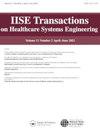疫苗供应链无人机配送网络设计:以尼日尔为例
IF 1.5
Q3 HEALTH CARE SCIENCES & SERVICES
IISE Transactions on Healthcare Systems Engineering
Pub Date : 2023-10-14
DOI:10.1080/24725579.2023.2268113
引用次数: 0
摘要
摘要本研究旨在评估无人机在低收入和中低收入国家偏远地区运送儿科疫苗的使用情况。在这些地区运送疫苗具有挑战性,因为道路网络不足,运输距离长,难以在运送过程中保持冷链的完整性。我们提出了一个混合整数线性规划,以确定无人机枢纽的位置,以方便疫苗的递送。该模型考虑了无人机的操作属性、疫苗在供应链中的浪费、冷藏和运输能力。我们利用尼日尔的数据开展了一个案例研究,以确定无人机运送对改善疫苗供应的影响。根据我们的数值分析,区域中心应该被视为无人机枢纽的潜在位置。我们证明,由无人机运送疫苗支持的外展会议可以改善疫苗的可得性。这些改进取决于建造无人机中心和购买无人机的可用预算,可用的冷库容量和研究区域的人口密度。关键词:无人机递送网络低收入和中低收入国家的疫苗供应链混合整数线性规划尼日尔的疫苗供应链免责声明作为对作者和研究人员的服务,我们提供此版本的已接受稿件(AM)。在最终出版版本记录(VoR)之前,将对该手稿进行编辑、排版和审查。在制作和印前,可能会发现可能影响内容的错误,所有适用于期刊的法律免责声明也与这些版本有关。作者报告说,没有与本文所述工作相关的资金。本文章由计算机程序翻译,如有差异,请以英文原文为准。
Designing Drone Delivery Networks for Vaccine Supply Chain: A Case Study of Niger
AbstractThis research aims to evaluate the use of drones to deliver pediatric vaccines in remote areas of low-income and low-middle-income countries. Delivering vaccines in these regions is challenging because of the inadequate road networks and long transportation distances that make it difficult to maintain the cold chain’s integrity during delivery. We propose a mixed-integer linear program to determine the location of drone hubs to facilitate vaccine delivery. The model considers the operational attributes of drones, vaccine wastage in the supply chain, cold storage, and transportation capacities. We develop a case study using data from Niger to determine the impact of drone deliveries in improving vaccine availability. Based on our numerical analysis, regional centers should be considered potential locations for drone hubs. We demonstrate that outreach sessions supported by drone deliveries of vaccines can improve vaccine availability. These improvements depend on the available budget to build drone hubs and purchase drones, available cold storage capacity, and the population density in the study region.Keywords: Drone delivery networkVaccine supply chain in low-income and low-middle-income countriesMixed-integer linear programNiger’s vaccine supply chainDisclaimerAs a service to authors and researchers we are providing this version of an accepted manuscript (AM). Copyediting, typesetting, and review of the resulting proofs will be undertaken on this manuscript before final publication of the Version of Record (VoR). During production and pre-press, errors may be discovered which could affect the content, and all legal disclaimers that apply to the journal relate to these versions also. FundingThe author(s) reported there is no funding associated with the work featured in this article.
求助全文
通过发布文献求助,成功后即可免费获取论文全文。
去求助
来源期刊

IISE Transactions on Healthcare Systems Engineering
Social Sciences-Safety Research
CiteScore
3.10
自引率
0.00%
发文量
19
期刊介绍:
IISE Transactions on Healthcare Systems Engineering aims to foster the healthcare systems community by publishing high quality papers that have a strong methodological focus and direct applicability to healthcare systems. Published quarterly, the journal supports research that explores: · Healthcare Operations Management · Medical Decision Making · Socio-Technical Systems Analysis related to healthcare · Quality Engineering · Healthcare Informatics · Healthcare Policy We are looking forward to accepting submissions that document the development and use of industrial and systems engineering tools and techniques including: · Healthcare operations research · Healthcare statistics · Healthcare information systems · Healthcare work measurement · Human factors/ergonomics applied to healthcare systems Research that explores the integration of these tools and techniques with those from other engineering and medical disciplines are also featured. We encourage the submission of clinical notes, or practice notes, to show the impact of contributions that will be published. We also encourage authors to collect an impact statement from their clinical partners to show the impact of research in the clinical practices.
 求助内容:
求助内容: 应助结果提醒方式:
应助结果提醒方式:


